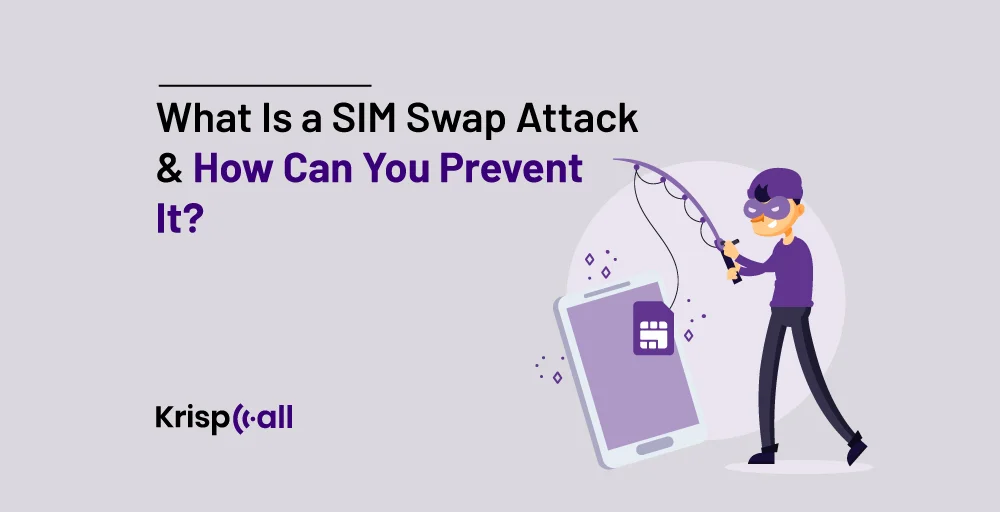Are you sure your bank account is safe? 🔒
In November 2022, the FBI warned about SIM swap attacks, claiming that around $68 million was estimated to be lost in SIM swap attacks in 2021.
SIM swapping is a cybercrime where every access to your phone services gets direct to scammers’s SIM. Instead of going after your passwords or usernames, this attack focuses on stealing the verification codes that are sent to your phone via calls or texts as part of the login process.
In this article, we will cover all the information regarding SIM swap attacks, including what they are, how they work, prevention methods, and what actions you should take if you’re a victim.
🔑 KEY HIGHLIGHTS
- SIM swap attack is a crime where criminals switch your mobile services to the SIM they control.
- SIM swap scams are done by attackers fooling the mobile carrier to transfer the services into their SIM.
- Changing online behavior, ensuring that you do not provide personal information on digital platforms, and using strong Passwords or PIN codes can enhance account security.
- If you suspect a scam, contact mobile carriers as soon as possible, secure financial accounts, and improve account security.
What is a SIM swap attack?
SIM swap attack, also termed “sim jacking” or “sim hacking,” is a cybercrime in which the attackers control the victim’s SIM card and switch the victim’s service to the attackers’ SIM card. The primary objective of attackers here is to gain access to bank accounts by conquering two-factor authentication.
Every SIM card has its unique identity, an essential component for mobile connectivity that leads to the correct network flow to the right device. But if you are a victim of a SIM swap scam, your mobile accounts get linked to a different SIM, which allows the network to divert to the attacker’s SIM. This allows the attackers to access your sensitive information.
How does a SIM swap attack work?
SIM swap works by scammers gaining control over your phone. They do this by persuading your mobile service provider to activate their services on a different SIM card.
To operate this scam, attackers try to convince your mobile carrier that the previous SIM had been broken, damaged, or for any other reason. When the service provider asks for personal information for verification, criminals provide your personal details, which they get through databases, data breaches, and the dark web.
Sometimes, scammers also use phishing or “Smishing” to trick you into sharing personal details by pretending to be a legitimate company or government agency. Clicking on their fraudulent links can give them access to your phone, including text messages containing verification codes from your bank.
After getting the personal details, fraudsters successfully switch your mobile service to their SIM. Upon completion of the SIM swap, the scammer can now access any accounts that use your phone as a second factor in two-factor authentication (2FA). They can control your online accounts, receive calls and messages sent on your phone, and in most cases, transfer your money to their bank account.
Signs you might be a victim of a SIM swap attack
The faster you know you are under a SIM swap attack, the more damage you can avoid. That is why you need to be aware of signs that may occur while someone swaps your SIM.
Here are some of the signs to know if you have been SIM swapped:
- Unable to make calls and send messages: If you cannot make calls and messages, it could be because of a disturbance in the network. Still, it could also be a possibility that your mobile services or phone number has been transferred to a different number through a SIM swap attack.
- Unauthorized bank activity: SIM swapping’s main aim is to drain money from your accounts, so if you get unusual messages regarding money transactions, it could be a result of a SIM swap attack.
- Denied account access: In a SIM swap scam, the attacker’s first step is to remove you from all your online account logins. Losing login access to your accounts is one of the surest signs of a SIM swap scam. If so, you need to take action as soon as possible.
- Suspicious emails or messages: If you receive any notifications or emails regarding the access request or verification codes, it might be a trap for SIM swapping. Sometimes, you can also get messages from your bank or service regarding some unusual activities. It is possible that someone is trying to scam you.
What are the actions to take if you’re the victim of a SIM swap scam?
If you discover that your SIM has been swapped, you must act quickly to prevent more damage.
Follow these steps to gain control over your services and accounts quickly:
1. Contact your mobile carrier
If your SIM has been swapped, the first action is to contact your cellular service provider as soon as possible. You can ask them to block all scammers’ access to your networks before the scammers cause massive damage to your accounts.
2. Secure financial accounts
Don’t panic. Clearly explain the situation to your service provider. You can ask them to freeze your accounts temporarily to prevent transactions made by criminals. Check every transaction and start the dispute process for the unauthorized transactions.
3. Enhance account security
You can temporarily disable two-factor authentication ( 2FA ) to focus on your account security. For more security, you must change your passwords and remember to put a strong and unique password. After you have every service back under your control, you should re-enable 2FA. You should use every available security feature and enable notifications for your accounts to avoid future swapping attacks.
How can you prevent SIM swap attacks?
The damage SIM swap attacks cause is massive, not only economically but also in terms of privacy. So, the more you are aware of them, the better you can prevent yourself from being a victim.
Some of the ways to prevent SIM swap attacks are listed below:
1. Modify online behavior
Social media negatively affects everyone’s privacy; sharing personal information such as names, addresses, phone numbers, and birth dates on digital media can harm on a large scale.
So, changing the habit of clicking unknown links and getting away from social sites can help you prevent it. You must be cautious in online activities to be safe from such attacks. Look up to news and other updates to inform you of such scams.
2. Avoid sharing personal info
Trusting someone’s message can be a blunder in a world of digital crimes. If you receive requests regarding your personal information through calls, emails, or texts, you must research them and only trust the legitimate ones.
Note that legitimate companies or organizations don’t ask for personal details through digital channels. So, refrain yourself from sharing personal info through emails, messages, or calls.
3. Enhance account security
When it comes to the security of your mobile services, you need to focus on making them as secure as possible. Two-factor authentication, which requires secondary verification beyond passwords, can be used for your accounts.
Also, use as strong and unique passwords as possible; you can also use password managers to secure your accounts. Follow every SIM-specific security method provided by your mobile carrier.
4. Use PIN codes and alternative authentication methods
If your mobile carrier allows you to use different PIN codes for communications, then utilize the opportunity. PIN codes can add another layer of security to your accounts. Alternative authentication methods like two-factor authentication(2FA) can also be a wise step.
5. Set up alerts for account changes
Enabling notifications and alerts for your bank and mobile carrier accounts keeps you informed about all the transactions and activities. If someone tries to do unusual or unauthorized activities, alerts can alert you.
The more early you detect the activities, the more time you get to prevent SIM swapping or other scamming activities.
6. Consider phoneless for sensitive accounts
To enhance security for sensitive accounts, consider removing the link to your phone and SIM card altogether. Although this might be inconvenient, it eliminates the risk of attacks like SIM swapping.
By doing so, you don’t need to worry about attacks from SIM swapping, which will eventually create a peaceful situation for you. This can be a way to secure your accounts from scammers.
7. Utilize authentication apps
Using authentication apps like Google Authenticator for additional security can be a good choice. It provides multiple layers of protection against unauthorized access to your accounts, including two-factor (2FR) authentication security.
Final Thoughts
SIM swap attacks occur when attackers control your SIM card and switch your service to the attackers’ SIM card. Often, the attackers try to fool the mobile carrier to succeed in the attack. If you experience issues like being unable to make calls or send texts, notice unusual activities in your accounts, or receive suspicious messages, it could be a sign of a scam attempt.
There are several prevention methods you can take to stop attacks before they occur. These include adjusting your online behavior, strengthening your account security, refraining from sharing personal information, and opting for phoneless options for sensitive accounts. Remember that clicking links over phishing traps, sharing information, and trusting people on the Internet can be a blunder in today’s world.
FAQ
Is SIM swapping still a threat?
Yes, it is. Despite using prevention methods and high security, the rate of SIM swapping attacks is increasing frequently. If you become a victim of such scams, you should act quickly and contact your service provider.
Is SIM swapping a crime?
Yes, SIM swapping is a cybercrime in which cybercriminals fool your cell provider into switching mobile services on their SIM card. For this, they steal your information from databases, data breaches, or darkwebs.
How do hackers SIM swap?
Hackers swap SIMs by sending phishing emails or messages combined with social engineering tactics to obtain a victim’s personal information. Now, using this information, scammers convince the victim’s service provider to transfer the services into another SIM that the attacker controls.
How often do SIM swap attacks happen?
SIM swap attacks are occurring more frequently. According to the FBI, the bureau received 1,611 reports of SIM swaps in 2021, which resulted in a total loss of more than $68 million.
Can you prevent a SIM swap?
Yes, you can prevent SIM swaps from happening by focusing on these steps:
- Changing online behavior and avoiding clicking unknown links.
- Avoid sharing personal information anywhere digitally.
- Using security measures as much as possible.
- Using PIN codes and alternatives for better security.
- Using authentication apps for 2FA.
- Constantly monitoring and setting up alerts.





